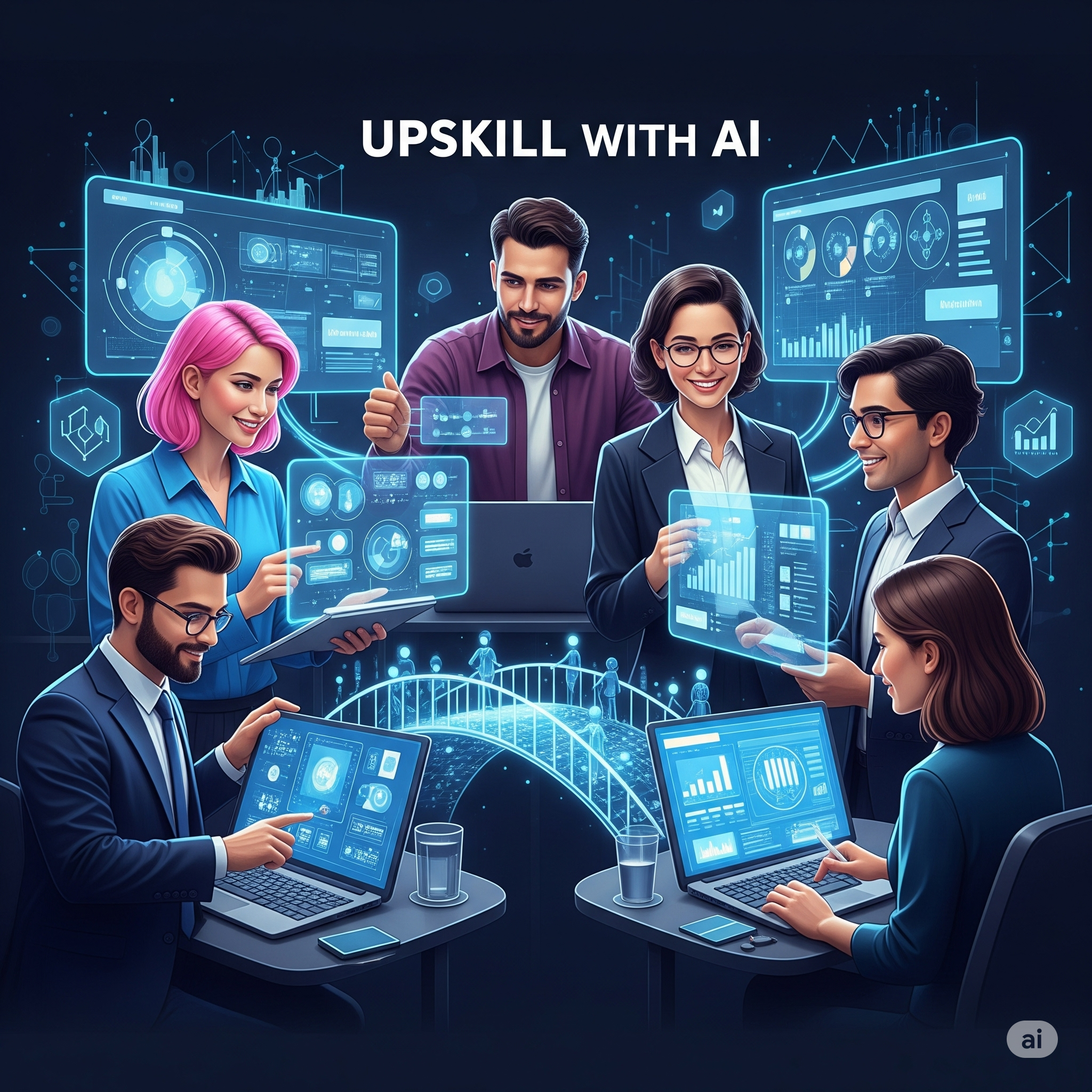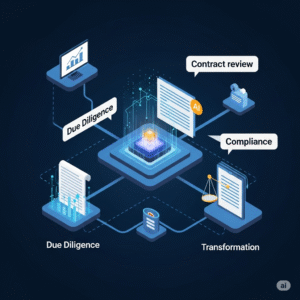As artificial intelligence rapidly transforms industries, a critical challenge looms over organizations worldwide—the AI skills gap. Despite investments and breakthroughs, the scarcity of professionals equipped to implement, manage, and optimize AI technologies is holding back business innovation. Overcoming the AI skills gap is not merely about hiring for technical talent; it requires continuous AI workforce training, dynamic reskilling, and a company-wide shift in mindset.
Recent studies indicate that up to half of all organizations lack the skilled talent required to execute their AI strategies, with more than 68% of executives reporting a moderate-to-extreme gap in AI capabilities. The AI skills gap isn’t just a tech-industry concern—it cuts across all sectors, from retail to manufacturing. The result? Missed opportunities, stalled digital transformation, and diminishing competitiveness in a data-driven world.
Understanding the AI Skills Gap: Causes and Current Trends
What Is the AI Skills Gap?
The AI skills gap refers to the mismatch between the rapid adoption of AI technologies and the availability of qualified professionals who can leverage these tools effectively within organizations. This gap manifests not just in advanced data science roles, but also in the everyday skills required for general AI literacy, business intelligence, and decision-making at all levels.
Why Is It Growing?
- Accelerating AI Adoption: Companies are integrating AI at a faster pace than ever, outstripping traditional training pipelines.
- Evolving Skill Sets: Emerging AI domains—like machine learning, natural language processing, and computer vision—require continuous learning and upskilling.
- Lack of Structured AI Training: Many organizations lag in providing comprehensive AI workforce training programs, resulting in inconsistent competency across teams.
- Global Talent Shortage: AI talent remains scarce worldwide, with only a small fraction of the workforce fully prepared for advanced AI roles.
Trending AI Skills in 2025
According to industry surveys, the most sought-after skills to address the AI skills gap include:
- Machine Learning expertise (with frameworks like TensorFlow, PyTorch)
- Natural Language Processing (NLP)
- Computer Vision applications
- Data Science and Analytics (including big data tools)
- Generative AI and Large Language Models (LLMs)
- AI Governance and Ethics
- MLOps and cloud-based AI deployment
- Business analysis and data storytelling
The Business Impact: How the AI Skills Gap Limits Progress
Missed Opportunities for Innovation
Organizations lacking AI-savvy staff struggle to translate business needs into actionable insights. This hinders the rollout of automation, personalization, and data-driven decision-making. In sectors like healthcare, finance, and retail, the AI skills gap can mean slower adoption of life-saving diagnostics, optimized logistics, or hyper-personalized marketing.
Increased Operational Costs
Without a trained workforce, companies over-rely on external consultants or suffer from inefficient processes. The inability to automate repetitive tasks and leverage AI-driven analytics leads to higher labor costs and slower project delivery.
Competitive Disadvantage
Digital leaders who prioritize AI workforce training consistently outpace peers in both productivity and customer satisfaction. The gap between early adopters and laggards widens every year as skilled teams deploy innovative solutions while others play catch-up.
Closing the Gap: Comprehensive Strategies for AI Workforce Training
1. Foster a Culture of Continuous Learning
Building a future-ready workforce starts with embedding lifelong learning into company culture. Encourage curiosity, experimentation, and the pursuit of AI literacy at all levels.
- Make AI learning part of performance goals.
- Offer micro-credentials and certifications for completion of AI-related courses.
- Recognize and reward employees who upskill.
2. Conduct a Skills Gap Analysis
Systematically assess current staff competencies versus future role requirements. This data-driven approach helps tailor targeted AI workforce training programs for both technical and soft skills.
- Use tools and platforms that identify individual and departmental skill gaps.
- Prioritize urgent upskilling areas aligned with business objectives.
3. Invest in Scalable AI Training Programs
Organizations need structured programs to rapidly build AI skills at scale. Consider blended models combining online learning, instructor-led workshops, and hands-on labs.
- Onboarding Bootcamps: Quickly introduce new hires to foundational AI skills.
- Role-Based Training: Tailor content for business analysts, developers, and decision-makers.
- Mentorship and Coaching: Pair learners with experienced AI practitioners.
4. Prioritize Both Technical and Human-Centric Skills
AI workforce training is not just about coding or data science. AI systems require employees who are good at problem-solving, communication, and ethical decision-making.
Essential Skills for the AI-Driven Workplace
- Technical: Data analysis, AI system monitoring, digital tool proficiency.
- Human-centric: Critical thinking, adaptability, interpersonal communication, ethical reasoning.
Real-World Examples: AI Skills Gap in Action
Case Study 1: Tech Innovators Inc.—Personalized AI Upskilling for Developers
Situation: Tech Innovators Inc., a global software company, found traditional training methods too generic for their fast-evolving projects. Developers often lagged in key programming languages and modern frameworks.
AI Strategy: The company launched an AI-powered platform that created personalized learning paths for each developer, using data on current skills and ongoing projects.
Results:
- Faster skill acquisition and reduced onboarding time.
- A 20% jump in productivity after targeted AI workforce training.
- Higher employee satisfaction and retention rates.
Case Study 2: Retail Giants Ltd.—Standardizing Customer Service with AI Training
Situation: This retailer faced inconsistent customer service across hundreds of outlets.
AI Solution: Deployed an AI-powered training system that used store-specific data and customer feedback to tailor learning modules for each location.
Outcomes:
- Achieved uniform service quality and a 25% rise in customer satisfaction scores.
- Boosted sales and repeat business due to more knowledgeable, empowered staff.
Case Study 3: Manufacturing Co.—Upskilling for Advanced Automation
Scenario: A large manufacturing firm struggled with the technical demands of automated and robotic systems.
AI Workforce Training: Implemented interactive virtual simulations and hands-on AI modules for operators and technicians.
Key Gains:
- Enhanced proficiency in modern machinery.
- 15% increase in production efficiency.
- Reduced downtime and operational costs.
Practical Tips: How to Upskill Your Team with AI Workforce Training
Beginner-Friendly Steps for AI Adoption
- Start With the Basics: Focus on AI literacy—what AI can and cannot do. Coursera, HubSpot Academy, and OpenAI offer accessible, beginner-friendly modules.
- Select AI Tools Tailored to Business Needs: Prioritize tools relevant to your sector (see below).
- Integrate AI Training Into Everyday Work: Embed short, practical AI lessons into team meetings and onboarding.
- Encourage Experimentation: Let employees test AI applications like chatbots, workflow automation, and predictive analytics in controlled environments.
- Partner with Training Providers: Leverage proven online platforms for structured upskilling (Info-Tech, edX, Coursera).
Essential AI Tools for Business Intelligence
| Tool | Description | Official Site |
|---|---|---|
| Tableau | Visualizes and analyzes complex data, empowering users with data-driven insights. | tableau.com |
| ChatGPT | Advanced conversational AI model for generating text, automating support, content creation. | openai.com |
| MonkeyLearn | Text analysis tool for sentiment analysis, keyword extraction, and survey analytics. | monkeylearn.com |
| Power BI | Interactive dashboarding and data visualization for business users. | powerbi.microsoft.com |
| Zapier | Automates workflows by connecting thousands of business apps and tools. | zapier.com |
AI Skills Gap in Business Intelligence: Turning Data into Profit
AI-powered business intelligence platforms are helping companies bridge the AI skills gap by democratizing advanced analytics. Even non-technical staff can now extract insights and make data-driven decisions. Consider real-world applications:
- Predicting demand and optimizing inventory in retail.
- Automating report generation and sales forecasting in finance.
- Enhancing patient outcomes with diagnostic analytics in healthcare.
Example Workflow: Implementing AI-Powered Data Analysis (For Beginners)
- Connect Your Data: Use Power BI or Tableau to link spreadsheets, databases, and cloud sources.
- Automate Cleaning: Employ built-in AI models for data cleansing and normalization.
- Interactive Dashboards: Drag-and-drop widgets—no code required—to spot trends and anomalies.
- Generate Insights: Use MonkeyLearn or ChatGPT for sentiment analysis or text analytics on customer feedback.
- Share Reports: Automate exporting and emailing visualized reports through Zapier integrations.
Overcoming Barriers: Inclusion, Accessibility, and Diversity in AI Workforce Training
Widening Access to Upskilling
Despite notable progress, gender and age divides persist in AI training. Women and older employees are often underrepresented in AI programs, compounding the overall AI skills gap. Government and corporate-led initiatives should:
- Promote inclusive AI education accessible to all backgrounds.
- Offer flexible learning formats—self-paced, virtual, and in-person.
- Provide mentoring and financial support for underrepresented groups.
The Road Ahead: Building a Future-Ready AI Workforce
Closing the AI skills gap isn’t a one-time project—it’s an ongoing investment in both people and processes. Companies that embed AI upskilling into their DNA, foster curiosity, and equip all staff with relevant tools will emerge as leaders in tomorrow’s digital economy. The benefits go beyond technology—they enable flexible, creative, and resilient teams ready for the AI-powered world.
Recommended Next Steps for Leaders:
- Initiate a company-wide skills audit and launch targeted training programs immediately.
- Incentivize employees to achieve certifications in AI, data analytics, or business intelligence.
- Set up interdisciplinary teams combining AI experts with domain specialists to promote knowledge exchange.
- Review and update your organization’s digital literacy goals annually to keep pace with evolving demands.
Credible Resources & Further Reading
- OpenAI: About Generative AI & ChatGPT
- HubSpot: How AI Is Changing Business Strategy
- McKinsey: The State of AI in 2025
- AI virtual tutors: The Rise of AI Assistants in Student Support
- Adaptive Learning AI: How AI is Tailoring Education for Every Student
- AI Drug Discovery: Revolutionizing Pharmaceutical Research and Development



